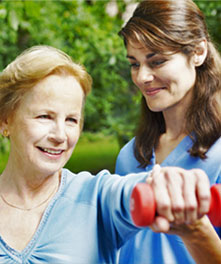Our smartphones, tablets, and laptops have connected us to the world in ways that we could never have imagined. We carry our offices, our social lives, and our entertainment with us everywhere we go. But this constant connectivity often comes with a trade-off, one...
If you find yourself frequently grappling with nagging pain in your neck, a persistent ache in your lower back, or tightness across your shoulders, your body might be telling you to fix your posture. These early signs of poor postural habits are just the tip of the...
Shoulder pain can affect much more than just our comfort. It can limit our ability to pick up our children, carry groceries, or even reach for something on a high shelf. If you’ve been struggling with nagging shoulder pain, there’s a strong possibility it may be due...
Hip Injury Prevention in the Elderly

According to the National Institute of Health (NIH), of people in the U.S. over the age of 50, approximately 10 million of them have osteoporosis of the hip. Nearly 34 million others have osteopenia of the hip, which puts them at risk for osteoporosis. By 2020, the NIH expects that half of all people over the age of 50 will have osteoporosis of the hip and more will be at risk for developing the disease in other bones.
Annually, of the millions of people over 50 who have osteoporosis, 300,000 of them fracture their hips. A year after the break, a surprising 20 percent die due to complications. Half will need walking assistance for the rest of their lives. All will be debilitated for a period of time and their recovery process may take a lot of time. When the consequences of a hip injury are so dire, measures to prevent hip injury need to be implemented.
Hip Injury Prevention Measures
Although some preventive measures seem like they are dictated by common sense, there are some things people do not think about until after they have fallen and fractured their hips.
- Exercises to improve strength and balance: Aging people often fear exercise, believing they may trip and fall. Certain exercises, like jogging, playing tennis or even walking on a treadmill are not recommended. On the other hand, regular walking or even riding on a stationary bicycle strengthen the muscles and bones and thereby reduce the risk of falling. Strong bones are less likely to fracture when and if a person does fall. Balance exercises, like yoga, increase the sense of balance and are also helpful in preventing falls.
- Wearing proper shoes: Women can still be fashionable, but need to avoid wearing high heels. Instead, focus on shoes that have good support and soles that are not slick and slippery. Wearing shoes in the house is also a good idea since some types of slippers and socks are less sturdy and make it easier to slip.
- Being careful about medications: Some medications cause dizziness or balance problems as side effects. Others, like corticosteroids, increase the risk of osteoporosis. According to some studies, people who take four or more medications have a higher risk of falls no matter what the side effects of their medications are.
- Good lighting: Aging people often find their vision is not as goo
d as it once was and they also get up more often at night to use the bathroom. They need to leave nightlights on so they can find their way without stumbling. For the rare occasion when the power goes off, they should keep a flashlight beside their bed. - Create a fall-prevention environment: Carpeted floors are better than slick ones. Clutter needs to be off the floor. Stairs should have handrails and bath tubs should have rubber slip-free mats.
Maintain health in general: Some health conditions also interfere with balance and sight. Cataracts come on slowly, but may make it difficult for people to notice obstacles in your path. Other conditions that affect mobility need to be treated.


